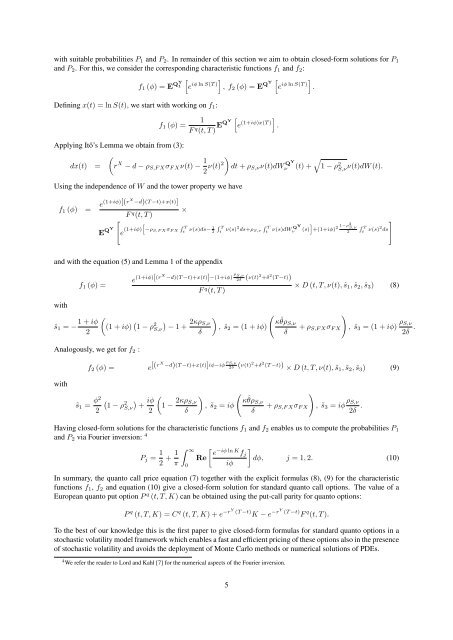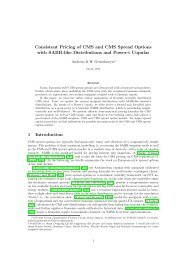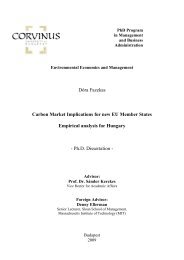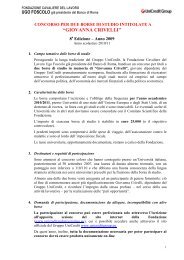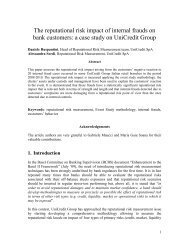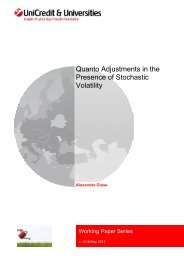Quanto Adjustments in the Presence of Stochastic Volatility
Quanto Adjustments in the Presence of Stochastic Volatility
Quanto Adjustments in the Presence of Stochastic Volatility
You also want an ePaper? Increase the reach of your titles
YUMPU automatically turns print PDFs into web optimized ePapers that Google loves.
with suitable probabilities P1 and P2. In rema<strong>in</strong>der <strong>of</strong> this section we aim to obta<strong>in</strong> closed-form solutions for P1<br />
and P2. For this, we consider <strong>the</strong> correspond<strong>in</strong>g characteristic functions f1 and f2:<br />
f1 (φ) = E QY<br />
�<br />
�<br />
1 iφ ln S(T<br />
e<br />
)�<br />
QY iφ ln S(T<br />
, f2 (φ) = E e<br />
)�<br />
.<br />
Def<strong>in</strong><strong>in</strong>g x(t) = ln S(t), we start with work<strong>in</strong>g on f1:<br />
f1 (φ) =<br />
1<br />
F q �<br />
(1+iφ)x(T<br />
EQY e<br />
)�<br />
.<br />
(t, T )<br />
Apply<strong>in</strong>g Itô’s Lemma we obta<strong>in</strong> from (3):<br />
dx(t) =<br />
�<br />
r X − d − ρS,F XσF Xν(t) − 1<br />
2 ν(t)2<br />
�<br />
dt + ρS,νν(t)dW QY<br />
�<br />
ν (t) + 1 − ρ2 S,νν(t)dW (t).<br />
Us<strong>in</strong>g <strong>the</strong> <strong>in</strong>dependence <strong>of</strong> W and <strong>the</strong> tower property we have<br />
f1 (φ) = e(1+iφ)[(rX −d)(T −t)+x(t)]<br />
E QY<br />
�<br />
F q (t, T )<br />
e (1+iφ)<br />
�<br />
−ρS,F X σF X<br />
and with <strong>the</strong> equation (5) and Lemma 1 <strong>of</strong> <strong>the</strong> appendix<br />
f1 (φ) =<br />
×<br />
� T<br />
t<br />
�<br />
1 T<br />
ν(s)ds− 2 t ν(s)2 � T<br />
ds+ρS,ν t<br />
e (1+iφ)[(rX −d)(T −t)+x(t)]−(1+iφ) ρ S,ν<br />
2δ (ν(t) 2 +δ 2 (T −t))<br />
F q (t, T )<br />
�<br />
QY<br />
ν(s)dWν (s) +(1+iφ) 2 1−ρ2 S,ν � T<br />
2 t ν(s)2 �<br />
ds<br />
× D (t, T, ν(t), ˆs1, ˆs2, ˆs3) (8)<br />
with<br />
�<br />
1 + iφ<br />
ˆs1 = − (1 + iφ)<br />
2<br />
� 1 − ρ 2 �<br />
�<br />
� 2κρS,ν<br />
κ<br />
S,ν − 1 + , ˆs2 = (1 + iφ)<br />
δ<br />
ˆ θρS,ν<br />
δ<br />
+ ρS,F<br />
�<br />
XσF X , ˆs3 = (1 + iφ) ρS,ν<br />
2δ .<br />
Analogously, we get for f2 :<br />
with<br />
f2 (φ) = e [(rX −d)(T −t)+x(t)]iφ−iφ ρ S,ν<br />
2δ (ν(t) 2 +δ 2 (T −t)) × D (t, T, ν(t), ˜s1, ˜s2, ˜s3) (9)<br />
˜s1 = φ2<br />
2<br />
�<br />
� � 2 iφ<br />
1 − ρS,ν + 1 −<br />
2<br />
2κρS,ν<br />
� �<br />
κ<br />
, ˜s2 = iφ<br />
δ<br />
ˆ θρS,ν<br />
δ<br />
+ ρS,F<br />
�<br />
XσF X , ˜s3 = iφ ρS,ν<br />
2δ .<br />
Hav<strong>in</strong>g closed-form solutions for <strong>the</strong> characteristic functions f1 and f2 enables us to compute <strong>the</strong> probabilities P1<br />
and P2 via Fourier <strong>in</strong>version: 4<br />
Pj = 1 1<br />
+<br />
2 π<br />
� ∞<br />
Re<br />
0<br />
� e −iφ ln K fj<br />
iφ<br />
�<br />
dφ, j = 1, 2. (10)<br />
In summary, <strong>the</strong> quanto call price equation (7) toge<strong>the</strong>r with <strong>the</strong> explicit formulas (8), (9) for <strong>the</strong> characteristic<br />
functions f1, f2 and equation (10) give a closed-form solution for standard quanto call options. The value <strong>of</strong> a<br />
European quanto put option P q (t, T, K) can be obta<strong>in</strong>ed us<strong>in</strong>g <strong>the</strong> put-call parity for quanto options:<br />
P q (t, T, K) = C q (t, T, K) + e −rY (T −t) K − e −r Y (T −t) F q (t, T ).<br />
To <strong>the</strong> best <strong>of</strong> our knowledge this is <strong>the</strong> first paper to give closed-form formulas for standard quanto options <strong>in</strong> a<br />
stochastic volatility model framework which enables a fast and efficient pric<strong>in</strong>g <strong>of</strong> <strong>the</strong>se options also <strong>in</strong> <strong>the</strong> presence<br />
<strong>of</strong> stochastic volatility and avoids <strong>the</strong> deployment <strong>of</strong> Monte Carlo methods or numerical solutions <strong>of</strong> PDEs.<br />
4 We refer <strong>the</strong> reader to Lord and Kahl [7] for <strong>the</strong> numerical aspects <strong>of</strong> <strong>the</strong> Fourier <strong>in</strong>version.<br />
5


